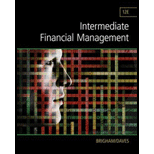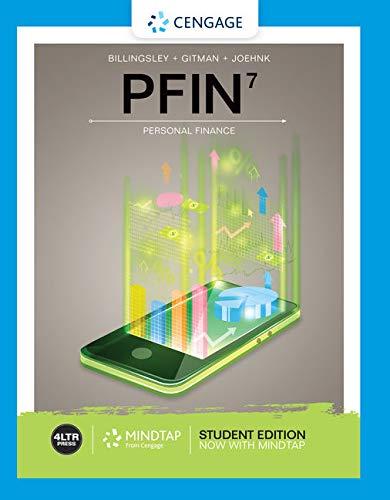
Concept explainers
Define each of the following terms:
- a. Project cash flow; accounting income
- b. Incremental cash flow; sunk cost;
opportunity cost ; externality; cannibalization; expansion project; replacement project - c. Net operating working capital changes; salvage value
- d. Stand-alone risk; corporate (within-firm) risk; market (beta) risk
- e. Sensitivity analysis; scenario analysis; Monte Carlo simulation analysis
- f. Risk-adjusted discount rate; project cost of capital
- g. Decision tree; staged decision tree; decision node; branch
- h. Real options; managerial options; strategic options; embedded options
- i. Investment timing option; growth option; abandonment option; flexibility option
a)
To discuss: Project cash flow and accounting income.
Explanation of Solution
Project cash flows is a part of financial planning for project, understanding the inflows and outflows of cash so one can be created by project. These cash flows are divided into three parts; they are initial investment for project, terminal or final cash flow and operating cash flow over life of the project.
Accounting income is the difference between total expenses and total revenues. It is the change in net profits over a period excluding any receipts from or expenses to owners.
b)
To discuss: Incremental cash flow, opportunity cost, sunk cost, cannibalization, externality, expansion project and replacement project.
Explanation of Solution
Incremental cost is the difference between cash flows of an organization which comes by undertaking project and without task the challenge. It is revenue – expense – initial cost.
Sunk cost is a cost that has already been occurred and cannot be recovered. It is also known as standard cost. It is the past opportunity cost that are irrecoverable and irrelevant to future decisions.
Opportunity cost is an economic concept of profits/value that a company offers up with the aid of taking an alternative action. It is benefit not going to be achieved due to a particular decision. It is also called as alternative cost.
Externality is nothing but third party effect arising from consumption and production of goods and services for which no appropriate compensation is paid. It is defined as negative or positive consequences of economic activity on third party.
Cannibalisation is the lack of product sale due to access of newly launched product. It is negative impact a new product has no sales performance of company’s existing product.
Expansion projects are those projects which help to expand the size of the firm by introducing new class of assets.
Under replacement projects, the existing assets are replaced with similar assets.
c)
To discuss: Net operating working capital changes and salvage value.
Explanation of Solution
Net operating working capital measures a company’s capability to pay all operating capital liabilities with its operational assets. It is a metric that indicates company leverage and current assets. It is the difference between current assets and current liabilities.
Salvage value is also known as scrap value or residual value. It is nothing but the estimated value of an asset at the end of its useful life.
d)
To discuss: Stand-alone risk, corporate risk and market risk.
Explanation of Solution
Stand-alone risk is the risk related to single asset or units of the company.
Corporate within the firm risk is the risk that a company project could have on its earnings.
Market/ beta risk is the risk that investment value may also change because of market factors as exchange rate, interest rate. It affects the overall performance of financial market.
e)
To discuss: Sensitivity analysis, Monte Carlo simulation analysis and scenario analysis.
Explanation of Solution
Sensitivity analysis is the technique which measures the effect of variation in a certain variable.
Scenario analysis is a kind of examination/ evaluation which provides a variety of possible outcomes, through an exam of various possible situations.
Monte Carlo simulation analysis is a mathematical technique used to measure the risk probability that various consequences in a process which aren’t easily predicted.
f)
To discuss: Risk adjusted discount rate, project cost of capital.
Explanation of Solution
Risk adjusted discount rate is the measure of present value of cash for investments involving high risk. It gauges how much threat is related in earning a particular return for investor.
Project cost of capital is the minimum required rate of return on project given the risk.
g)
To discuss: Decision tree, decision node, staged decision tree and branch.
Explanation of Solution
A decision tree is a way of structuring a set of sequential decisions, which is based on the consequences at specific points in time. A staged decision tree analysis divides the analysis into various phases.
At each phase a selection is made either to proceed or to stop the project. These decisions are denoted on the decision trees through circles and are known as decision nodes. Each path that relies upon on a decision is known as a branch.
h)
To discuss: Real options, managerial options, strategic options and embedded options.
Explanation of Solution
Real options occur when mangers can affect the size and risk of a project’s cash flows by way of taking different actions during the project’s life. They are known to as real options because they deal with real as opposed to financial assets.
They are also referred to as managerial alternatives because they give opportunities to managers to response to change market conditions. Sometimes they are called strategic alternatives due to fact they often cope with strategic issues. Finally, they are caked as embedded options because they are a part of another project.
i)
To discuss: Investment timing option, growth option, abandonment option and flexibility option.
Explanation of Solution
Investment timing option gives firms the option to delay a project instead of implement it immediately. This choice to wait permits an organization to reduce the uncertainty of market conditions before it comes to put to implement the project.
Capacity option allows a firm to change the capability in their output in response to changing marketplace conditions. This includes the option to contract or expand production.
Growth option permits a firm to expand if market place demand is better than expected. This includes the opportunity to expand into different geographic markets and the possibility to introduce complementary or second-generation products. It also includes the option to abandon a task if marketplace situations become worse too much.
Want to see more full solutions like this?
Chapter 13 Solutions
Intermediate Financial Management (MindTap Course List)
- What is the Net Present Value (NPV) of a project?A) The initial investment in a projectB) The difference between the present value of cash inflows and outflowsC) The expected cash inflows from a projectD) The total cost of financing a project need help!arrow_forwardWhat is the Net Present Value (NPV) of a project?A) The initial investment in a projectB) The difference between the present value of cash inflows and outflowsC) The expected cash inflows from a projectD) The total cost of financing a projectarrow_forwardWhat is the Payback Period in capital budgeting?A) The time it takes to recover the initial investmentB) The time it takes to achieve profitabilityC) The time it takes to double the investmentD) The time it takes to reach maximum revenuearrow_forward
- Required: Suppose you conduct currency carry trade by borrowing $1 million at the start of each year and investing in the New Zealand dollar for one year. One-year interest rates and the exchange rate between the U.S. dollar ($) and New Zealand dollar (NZ$) are provided below for the period 2000 - 2009. Note that interest rates are one-year interbank rates on January 1st each year, and that the exchange rate is the amount of New Zealand dollar per U.S. dollar on December 31 each year. The exchange rate was NZ$1.9090 per $ on January 1, 2000. Fill out columns (4) - (7) and compute the total dollar profits from this carry trade over the ten-year period. Also, assess the validity of uncovered interest rate parity based on your solution of this problem. You are encouraged to use the Excel spreadsheet software to tackle this problem. Note: Negative value should be entered with a minus sign. Enter profit value answers in dollars, rather than in millions of dollars. Do not round intermediate…arrow_forwardWhich of the following is considered a capital budgeting decision?A) Deciding how to finance a new projectB) Deciding whether to replace a machineC) Deciding how to manage cash reservesD) Deciding how to structure employee benefitsarrow_forwardOmni Advisors, an international pension fund manager, uses the concepts of purchasing power parity (PPP) and the International Fisher Effect (IFE) to forecast spot exchange rates. Omni gathers the financial information as follows: Base price level Current U.S. price level Current South African price level Base rand spot exchange rate Current rand spot exchange rate Expected annual U.S. inflation Expected annual South African inflation 100 105 111 $ 0.195 $ 0.178 7% 5% 10% 8% Expected U.S. one-year interest rate Expected South African one-year interest rate Required: Calculate the following exchange rates (ZAR and USD refer to the South African rand and U.S. dollar, respectively): a. The current ZAR spot rate in USD that would have been forecast by PPP. Note: Do not round intermediate calculations. Round your answer to 4 decimal places. b. Using the IFE, the expected ZAR spot rate in USD one year from now. Note: Do not round intermediate calculations. Round your answer to 4 decimal…arrow_forward
- You invest $5,000 in a project, and it generates $1,250 annually. How long will it take to recover your investment? Exparrow_forwardThe value of an investment grows from $10,000 to $15,000 in 3 years. What is the CAGR?Soovearrow_forwardSuppose that the treasurer of IBM has an extra cash reserve of $100,000,000 to invest for six months. The six-month interest rate is 9 percent per annum in the United States and 8 percent per annum in Germany. Currently, the spot exchange rate is €1.07 per dollar and the six-month forward exchange rate is €1.05 per dollar. The treasurer of IBM does not wish to bear any exchange risk. Where should they invest to maximize the return? Required: The maturity value in six months if the extra cash reserve is invested in Germany:arrow_forward
- The value of an investment grows from $10,000 to $15,000 in 3 years. What is the CAGR?arrow_forwardYou invest $5,000 in a project, and it generates $1,250 annually. How long will it take to recover your investment?arrow_forwardA company pays an annual dividend of $3 per share, and the current stock price is $50. What is the dividend yield?arrow_forward
 EBK CONTEMPORARY FINANCIAL MANAGEMENTFinanceISBN:9781337514835Author:MOYERPublisher:CENGAGE LEARNING - CONSIGNMENT
EBK CONTEMPORARY FINANCIAL MANAGEMENTFinanceISBN:9781337514835Author:MOYERPublisher:CENGAGE LEARNING - CONSIGNMENT Intermediate Accounting: Reporting And AnalysisAccountingISBN:9781337788281Author:James M. Wahlen, Jefferson P. Jones, Donald PagachPublisher:Cengage Learning
Intermediate Accounting: Reporting And AnalysisAccountingISBN:9781337788281Author:James M. Wahlen, Jefferson P. Jones, Donald PagachPublisher:Cengage Learning Managerial Accounting: The Cornerstone of Busines...AccountingISBN:9781337115773Author:Maryanne M. Mowen, Don R. Hansen, Dan L. HeitgerPublisher:Cengage Learning
Managerial Accounting: The Cornerstone of Busines...AccountingISBN:9781337115773Author:Maryanne M. Mowen, Don R. Hansen, Dan L. HeitgerPublisher:Cengage Learning Intermediate Financial Management (MindTap Course...FinanceISBN:9781337395083Author:Eugene F. Brigham, Phillip R. DavesPublisher:Cengage LearningPrinciples of Accounting Volume 2AccountingISBN:9781947172609Author:OpenStaxPublisher:OpenStax College
Intermediate Financial Management (MindTap Course...FinanceISBN:9781337395083Author:Eugene F. Brigham, Phillip R. DavesPublisher:Cengage LearningPrinciples of Accounting Volume 2AccountingISBN:9781947172609Author:OpenStaxPublisher:OpenStax College Pfin (with Mindtap, 1 Term Printed Access Card) (...FinanceISBN:9780357033609Author:Randall Billingsley, Lawrence J. Gitman, Michael D. JoehnkPublisher:Cengage Learning
Pfin (with Mindtap, 1 Term Printed Access Card) (...FinanceISBN:9780357033609Author:Randall Billingsley, Lawrence J. Gitman, Michael D. JoehnkPublisher:Cengage Learning





